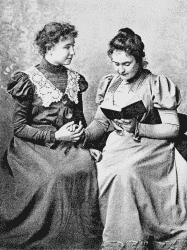Is Cryptomnesia Real?
When you forget what you remember...
 Cryptomnesia is defined as “The appearance in consciousness of memory images which are not recognized as such but which appear as original creations.” To put it more plainly, it the idea that we can recall things we’ve seen and heard but remember them as being original, rather than outside influences.
Cryptomnesia is defined as “The appearance in consciousness of memory images which are not recognized as such but which appear as original creations.” To put it more plainly, it the idea that we can recall things we’ve seen and heard but remember them as being original, rather than outside influences.
As we discussed in 2014, the topic is something of a taboo in plagiarism circles. Acknowledging that cryptomnesia is real opens the door to many plagiarisms being wholly unintentional, making it possible to accidentally plagiarize.
Plagiarism is widely seen as a strict liability offense, meaning that plagiarists are often held responsible regardless of their intent. But, if one can plagiarize due to a faulty memory rather than negligence or malice, the very premise of strict liability is called into question.
To make matters still more complicated, there’s a heavy debate about whether or not cryptomnesia is real or, if it is, to what extent it’s possible. That problem is made worse by the fact that so many caught plagiarists have falsely claimed to have had it happen, making it difficult to find real and confirmed cases.
With that in mind, we’re going to take a look at cryptomnesia, the main stories, the scientific research and try to answer one question: Is cryptomnesia real? And, if so, when is it likely to have happened?
Helen Keller: An Anecdote of Cryptomnesia
 One of the challenges with discussing cryptomnesia is that, for most of history, all of the evidence for it has been through self-reported anecdotal evidence.
One of the challenges with discussing cryptomnesia is that, for most of history, all of the evidence for it has been through self-reported anecdotal evidence.
Perhaps the best-known and most-debated case of cryptomnesia is Helen Keller.
Keller, as most likely know, was born in 1880 and went blind and deaf early in life but, with the help of her teacher, Anne Sullivan, went on to become an author and activist. Her autobiography, The Story of My Life, would go on to be adapted as a series of movies and plays entitled The Miracle Worker.
In 1891, when Keller was just 11 years old and had just learned how to write, she submitted a story entitled The Frost King to the head of the Perkins School for the Blind, which published it in their Alumni magazine. It was then picked up by the Goodson Gazette, a journal on deaf-blind education, that pushed it to a broader audience.
However, the next year, it was discovered that the story had a strong resemblance, including at least some lines, to another story entitled Frost Fairies by Margaret Canby.
In The Story of My Life, Keller recalled what happened. According to Keller, she could not recall having been read Frost Fairies or the book it was in. However, after some investigating (with the help of Dr. Alexander Graham Bell) it was discovered that, while she didn’t own the book, she spent a summer a few years prior at the home of Sophia Hopkins, Sullivan’s mentor, while Sullivan was on vacation. There, she claimed, she was read the story.
Keller was tried by a school “court” that consisted of four sighted people and four blind ones. They interrogated her and was eventually split 4-to-4 on whether she had knowingly plagiarized. The tie-breaking vote was cast in Keller’s favor by Michael Anagnos, the head of the Perkins School and a friend of Keller.
Though cleared, the incident was deeply traumatic to the young Keller, who says she stopped writing fiction afterward and nearly gave up writing altogether.
Keller said this was because she had a difficult time separating what was original to her from what was read to her, saying, “Likewise my compositions are made up of crude notions of my own, inlaid with the brighter thoughts and riper opinions of the authors I have read.”
She went on to say that, “But the fact remains that Miss Canby’s story was read to me once, and that long after I had forgotten it, it came back to me so naturally that I never suspected that it was the child of another mind.”
Though Keller felt understandably attacked, she found many allies, including Mark Twain, who wrote a strongly-worded letter in her defense. There, he referred to the allegations against her as “grotesque” and said said he had experienced many similar incidents.
While Keller remained firm about the cryptomnesia, others who have studied her life are less convinced. One of which is biographer Joseph Lash who, in 1980, published the book Helen and Teacher. With access to new documents, namely an account from one of Keller’s teachers, it’s argued that Keller been read Frost Fairies recently, not years before, and it was Sullivan, not Hopkins, who had read it to her.
According to Lash, it’s likely that Keller wrote The Frost King as a paraphrased story, a writing practice she had been doing in her letters, and Sullivan, either feeling it was original enough or not understanding the nuances of plagiarism, submitted it for publication.
The truth, however, is something we’ll probably never fully know. But even if it is a case of cryptomnesia, it’s far from the only probable explanation. Though it’s unlikely that Keller knew she was doing anything wrong (especially given her age and newness to writing), there are plenty of other ways the story could have ended up published.
But this is true of most cryptomnesia anecdotes. Other explanations are almost always available. What’s been needed is research into the topic and that is something that we’ve finally been getting in recent decades.
Research into Cryptomnesia
Research into memory and how it works has been showing us just how flawed our recollection of things really is. Eyewitness testimony is notoriously unreliable, false memories can trivially be implanted into our brains and memories fade with age.
It also makes sense that, as we look into the ways our memories fail us, we also discover how we can misattribute some of our memories.
In 1989 a Southern Methodist University psychologist, Dr. Alan S. Brown, and a student of his, Dr. Dana Murphy, published the results of a series of experiments in this area. They found that, in 3 to 9 percent of cases, participants would inadvertently attribute other people’s ideas to themselves.
The initial experiment involved having a group of participants come up with solutions to a problem. Each was asked to come up with four separate ideas but to not repeat any others that were previously suggested. Weeks or months later, they were asked to return and indicate what they contributed. In a third session, they were tasked with coming up with new ideas.
This experiment, as well as later ones testing how participants remembered information presented visually (rather than socially), found that participants would regularly attribute other people’s ideas to themselves but would rarely attribute their ideas to others. Likewise, the more complicated the process of generating a response was, the more likely cryptomneesia was likely to occur.
Other scientists have replicated these experiments and seen similar findings. They’ve also found that the more one focuses on the source of a piece of information, the more likely they are to recall where it’s from. Likewise, the less attention and the more difficult it is for the person to track the source, the more likely cryptomnesia becomes.
However, cryptomnesia doesn’t just relate to information from outside sources. Many people falsely believe an idea that they think is new is actually something they’ve done before.
I’ve seen this myself with Plagiarism Today, often times sitting down to write a new article only to learn that an article I already wrote on the subject is one of the top results in Google.
But, while the existence of cryptomnesia has been confirmed, there’s a very serious limitation with it: It doesn’t explain most cases of plagiarism.
The reason is because the same memory flaw that makes cryptomnesia possible also makes many of the claimed cases of it completely impossible.
The Limits of Cryptomnesia
The limits of cryptomnesia is fairly straightforward: It only pertains to things that are easy to remember without paying much attention.
Where cryptomnesia has been shown it is with things like ideas, jokes, melodies, words or short phrases. That’s because it’s easy for our brains to remember these things without too much effort. When something can be easily remembered, especially in a situation where one is attempting to focus on many things, it’s easy to forget where it came from.
But the more detailed a plagiarism gets or the more involved it becomes, the less likely cryptomnesia is the culprit. Looking at the recent case of the TV crime procedural Instinct plagiarizing the show Bones, while it’s easy to believe that an idea or a single detail could be transferred via cryptomnesia, the sheer number of overlapping scenes, details and dialogue lines make it effectively impossible.
The reason is because memorizing all of those elements well enough to recall weeks, months or years later would be nearly impossible. I wrote my article on the similarities just two days ago and watched the episodes the day before that. Already, my memories of the similarities are fading.
The fact that our memories are flawed is what makes cryptomnesia possible, but it also makes it impossible when the amount one has to remember is simply too great.
So when a student claims that they plagiarized a paragraph of text because of cryptomnesia, it, according to the research we have, is not a legitimate claim.
Cryptomnesia happens, but not the way many plagiarists try to claim it does.
Bottom Line
Cryptomnesia is very real. It’s a real phenomenon that has been tracked in many replicated, peer-reviewed scientific studies and it’s a theory that fits well with our understanding of how memory works (or doesn’t work).
However, cryptomnesia is not an easy out for plagiarism. We are not robots remembering all of the information fed to us while forgetting the attribution. The flaws in our memory that makes cryptomnesia possible also makes it difficult to do it with anything of great length, detail or complexity.
The vast majority of plagiarism cases can not be explained through cryptomnesia. It’s a real phenomenon with great impacts on our understand of how our brains work, but far fewer impacts on the realm of plagiarism.
So while it is important to know that cryptomnesia does exist, don’t expect it to be an important part of many, let alone, most, plagiarism cases.
Want to Reuse or Republish this Content?
If you want to feature this article in your site, classroom or elsewhere, just let us know! We usually grant permission within 24 hours.
